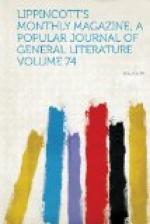[Illustration: THE TIBER NEAR PERUGIA.]
The conquering Roman has left his sign-manual everywhere, but one is so used to him in Italy that the scantier records of later ages interest us more here. Like every other old Italian town, Perugia had its great family, the Baglioni, who lorded it over the place, sometimes harshly and cruelly enough, sometimes generously and splendidly—protectors of popular rights and patrons of art and letters. Their mediaeval history is full of picturesque incident and dramatic catastrophe: it would make a most romantic volume, but a thick one. At length the Perugians, master and men, grew too turbulent, and Pope Paul III. put them down, and sat upon them, so to speak, by building the citadel.
But time would fail us to tell of the Baglioni, or Pope Paul the Borghese, or Fortebraccio, the chivalric condottiere who led the Perugians to war against their neighbors of Todi, or even the still burning memories of the sack of Perugia by command of the present pope. We can no longer turn our thoughts from the treasures of art which make Perugia rich above all cities of the Tiber, save Rome alone. We cannot tarry before the cathedral, noble despite its incompleteness and the unsightly alterations of later times, and full of fine paintings and matchless wood-carving and wrought metal and precious sculptures; nor before the Palazzo Communale, another grand Gothic wreck, equally dignified and degraded; nor even beside the great fountain erected six hundred years ago by Nicolo and Giovanni da Pisa, the chiefs and founders of the Tuscan school of sculpture; nor beneath the statue of Pope Julius III., which Hawthorne has made known to all; for there are a score of churches and palaces, each with its priceless Perugino, and drawings and designs by his pupil Raphael in his lovely “first manner,” which has so much of the Eden-like innocence of his master; and the Academy of Fine Arts, where one may study the Umbrian school at leisure; and last, but not least, the Sala del Cambio, or Hall of Exchange, where Perugino may be seen in his glory. It is not a hall of imposing size, so that nothing interferes with the impression of the frescoes which gaze upon you from every side as you enter. Or no; they do not gaze upon you nor return your glance, but look sweetly and serenely forth, as if with eyes never bent on earthly things. The right-hand wall is dedicated to the sibyls and prophets, the left to the greatest sages and heroes of antiquity. There is something capricious or else enigmatical in the mode of presenting many of them—the dress, attitude and general appearance often suggest a very different person from the one intended—but the grace and loveliness of some, the dignity and elevation of others, the expression of wisdom in this face, of celestial courage in that, the calm and purity and beauty of all, give them an indescribable charm and potency. At the end of the room facing the door are the “Nativity” and “Transfiguration,”




